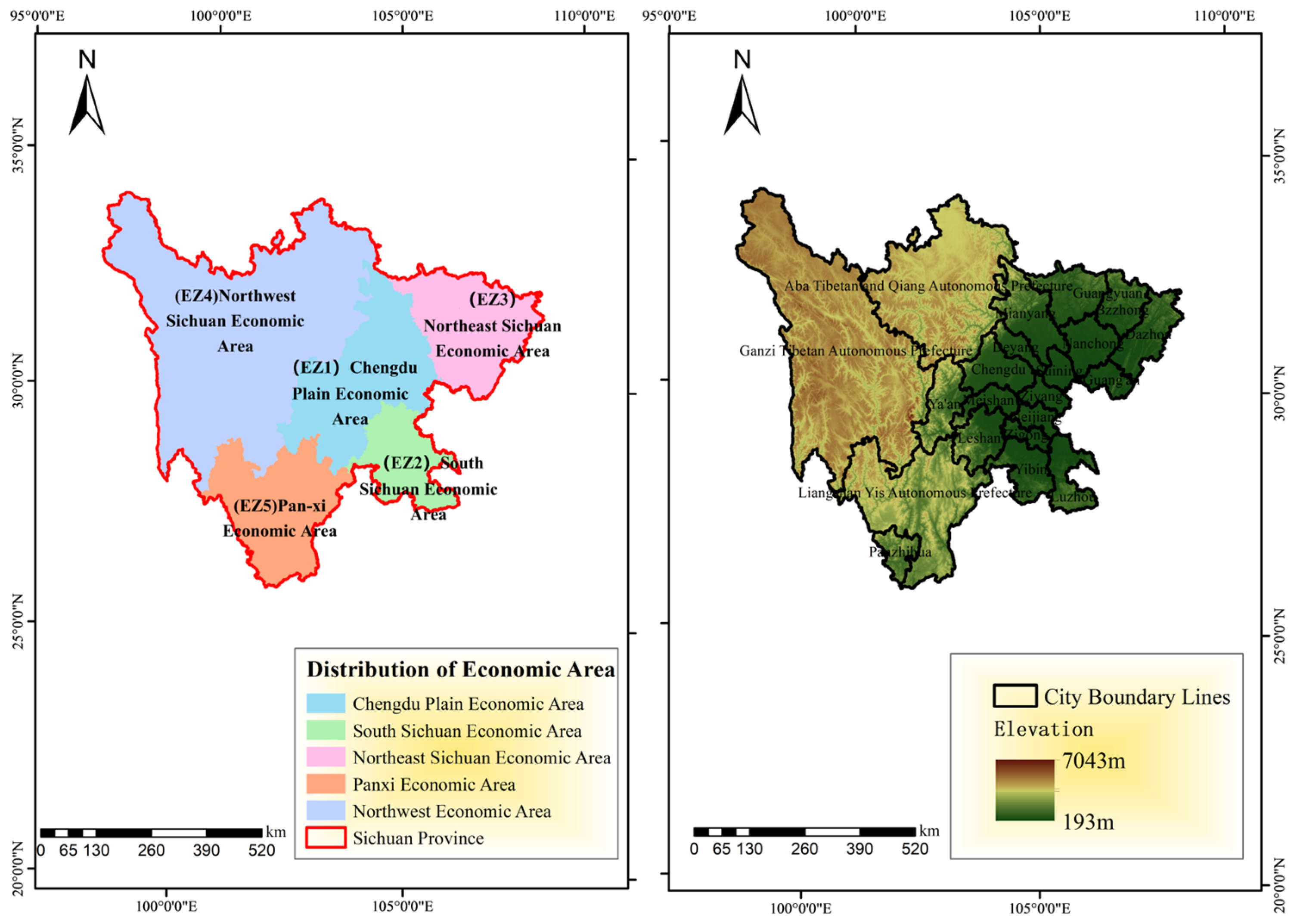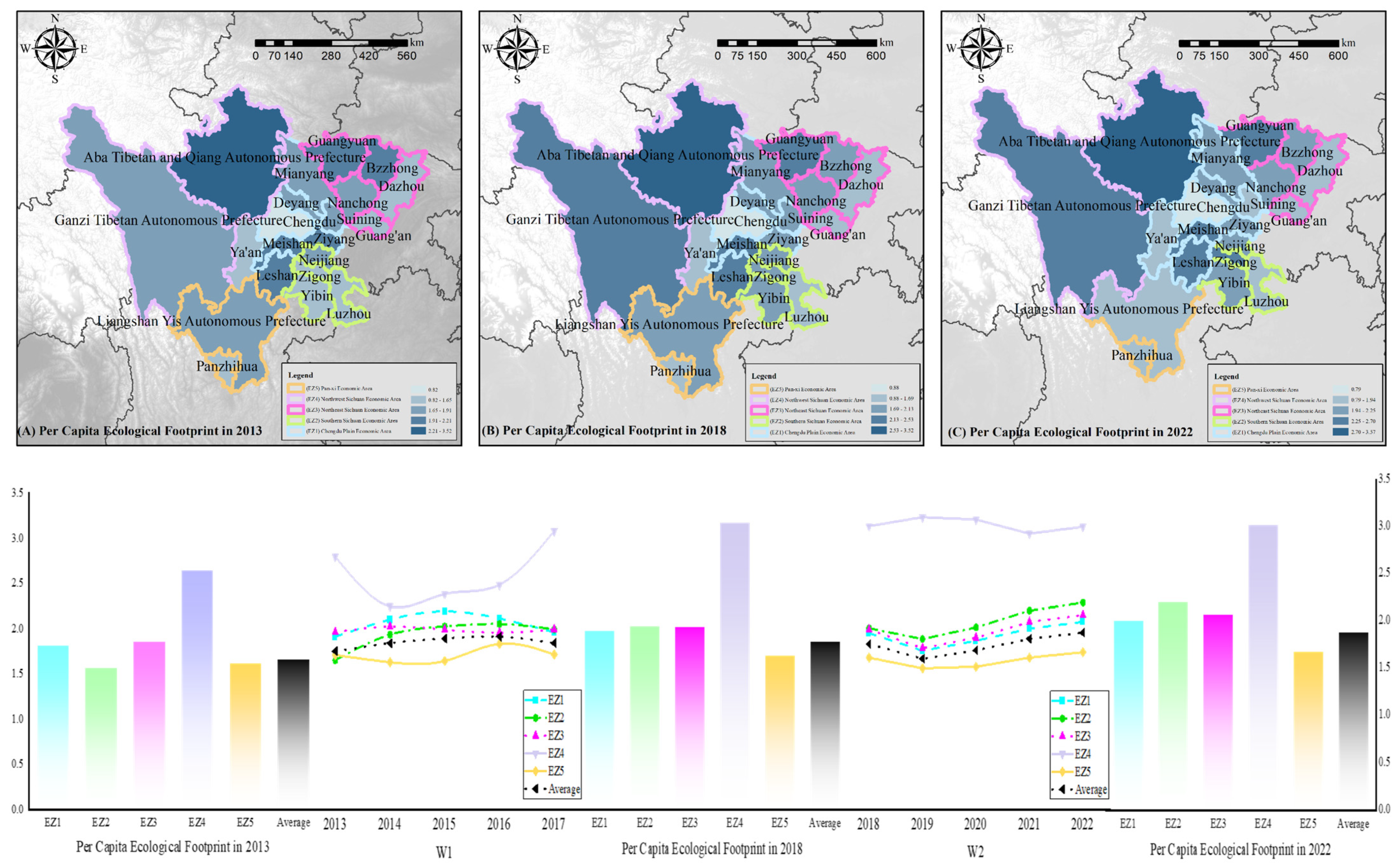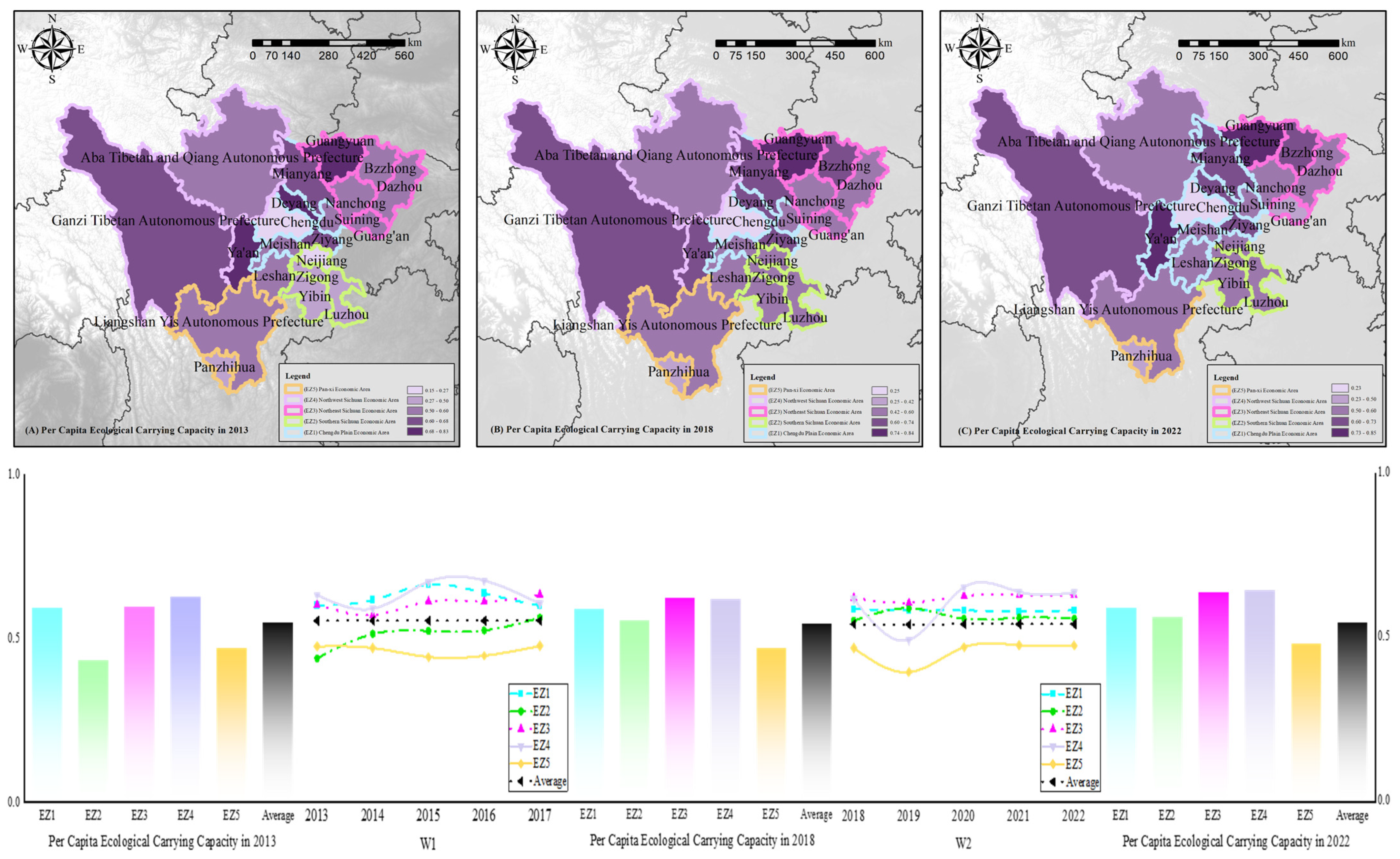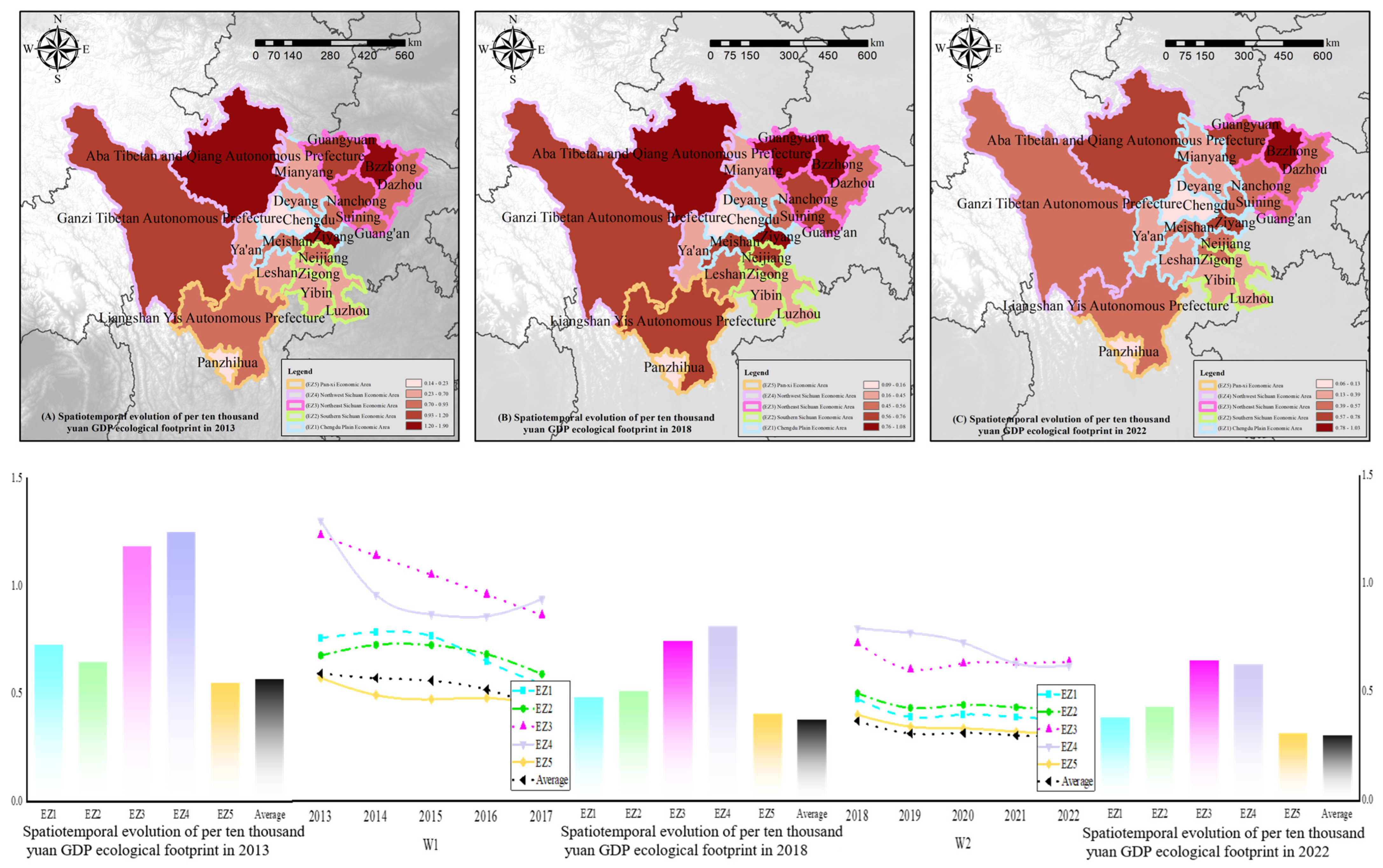Spatiotemporal Evolution and Drivers of Ecological Footprint: A Case Study of Sichuan Province from an Economic Area Perspective
Abstract
1. Introduction
2. Materials and Methods
2.1. Study Area
2.2. Data Resources
2.3. Methods
3. Results
3.1. Variation Characteristics of Ecological Footprint
3.1.1. Per Capita Ecological Footprint
3.1.2. Per Capita Ecological Carrying Capacity
3.1.3. Ecological Footprint per 10,000 Yuan GDP
3.2. Variation Characteristics of Ecological Security Centroid
3.3. Analysis of the Main Influencing Factors of Ecological Footprint
3.3.1. Single Factor Detection Analysis
3.3.2. Dual-Factor Interactive Detection Analysis
4. Discussion
4.1. Academic Contributions
4.2. Research Prospects
5. Conclusions
- (1)
- Chengdu Plain Economic Area: Future development should maintain the “modern economy + ecological sustainability” model by enhancing R&D-driven emission reduction and strictly controlling urban land expansion.
- (2)
- Southern Sichuan Economic Area: The core strategy should center on the “basin economic ecological corridor” concept aligned with the Belt and Road Initiative, focusing on protecting critical river corridors while establishing watershed ecological compensation mechanisms.
- (3)
- Northeastern Sichuan Economic Area: Emphasize “building ecologically intensive farmland along the red line” through advanced agricultural technologies and high-standard farmland development.
- (4)
- Northwestern Sichuan Economic Area: Adopt an ‘ecological economy + ecological restoration’ approach by developing eco-tourism and plateau-specific agriculture, coupled with climate adaptation measures.
- (5)
- Pan-xi Economic Area: Strengthen the ‘agricultural economy + soil and water conservation’ to establish a distinctive ‘Second Granary of Tianfu’, while promoting green mineral development and enhanced ecological protection.
Author Contributions
Funding
Institutional Review Board Statement
Informed Consent Statement
Data Availability Statement
Conflicts of Interest
References
- Yao, J.; Xu, P.; Huang, Z. Impact of Urbanization on Ecological Efficiency in China: An Empirical Analysis Based on Provincial Panel Data. Ecol. Indic. 2021, 129, 107827. [Google Scholar] [CrossRef]
- Ali, R.; Kuriqi, A.; Kisi, O. Human–Environment Natural Disasters Interconnection in China: A Review. Climate 2020, 8, 48. [Google Scholar] [CrossRef]
- Sukumaran, K. Impact of Human Activities Inducing and Triggering of Natural Disasters. In A System Engineering Approach to Disaster Resilience, Proceedings of the VCDRR 2021, Virtual, 15–20 March 2021; Ghosh, C., Kolathayar, S., Eds.; Springer Nature: Singapore, 2022; pp. 17–31. [Google Scholar]
- Mishra, H. Environmental Degradation and Impacts on Agricultural Production: A Challenge to Urban Sustainability. In Sustainable Urban Environment and Waste Management: Theory and Practice; Parray, J.A., Shameem, N., Haghi, A.K., Eds.; Springer Nature: Singapore, 2025; pp. 53–92. ISBN 978-981-96-1140-9. [Google Scholar]
- Karwacka, M.; Ciurzyńska, A.; Lenart, A.; Janowicz, M. Sustainable Development in the Agri-Food Sector in Terms of the Carbon Footprint: A Review. Sustainability 2020, 12, 6463. [Google Scholar] [CrossRef]
- Festus, I.A.; Omoboye, I.F.; Andrew, O.B. Urban Sprawl: Environmental Consequence of Rapid Urban Expansion. Malays. J. Soc. Sci. Humanit. MJSSH 2020, 5, 110–118. [Google Scholar] [CrossRef]
- Danielsen, F.; Eicken, H.; Funder, M.; Johnson, N.; Lee, O.; Theilade, I.; Argyriou, D.; Burgess, N.D. Community Monitoring of Natural Resource Systems and the Environment. Annu. Rev. Environ. Resour. 2022, 47, 637–670. [Google Scholar] [CrossRef]
- Rial, R.C. Biofuels versus Climate Change: Exploring Potentials and Challenges in the Energy Transition. Renew. Sustain. Energy Rev. 2024, 196, 114369. [Google Scholar] [CrossRef]
- Sharifi, A. Resilience of Urban Social-Ecological-Technological Systems (SETS): A Review. Sustain. Cities Soc. 2023, 99, 104910. [Google Scholar] [CrossRef]
- Bi, M.; Yao, C.; Xie, G.; Liu, J.; Qin, K. Improvement and Application of the Three-Dimensional Ecological Footprint Model. Ecol. Indic. 2021, 125, 107480. [Google Scholar] [CrossRef]
- Ahsan, S.S. Evaluation of Environmental Footprint Indicators for the Calculation of Personal Overshoot Day. Ph.D. Thesis, Politecnico di Torino, Torino, Italy, 2023. [Google Scholar]
- Hong, Z.; Xiao, K. Digital Economy Structuring for Sustainable Development: The Role of Blockchain and Artificial Intelligence in Improving Supply Chain and Reducing Negative Environmental Impacts. Sci. Rep. 2024, 14, 3912. [Google Scholar] [CrossRef]
- Jie, H.; Khan, I.; Alharthi, M.; Zafar, M.W.; Saeed, A. Sustainable Energy Policy, Socio-Economic Development, and Ecological Footprint: The Economic Significance of Natural Resources, Population Growth, and Industrial Development. Util. Policy 2023, 81, 101490. [Google Scholar] [CrossRef]
- Yang, Y.; Meng, G. The Evolution and Research Framework of Carbon Footprint: Based on the Perspective of Knowledge Mapping. Ecol. Indic. 2020, 112, 106125. [Google Scholar] [CrossRef]
- Zhou, C.; Zhang, R.; Loginova, J.; Sharma, V.; Zhang, Z.; Qian, Z. Institutional Logic of Carbon Neutrality Policies in China: What Can We Learn? Energies 2022, 15, 4391. [Google Scholar] [CrossRef]
- Zhou, C.; Zhang, W.; Richardson-Barlow, C. Navigating Ecological Civilisation: Polycentric Environmental Governance and Policy Regulatory Framework in China. Energy Res. Soc. Sci. 2025, 128, 104347. [Google Scholar] [CrossRef]
- Hallegatte, S.; Vogt-Schilb, A.; Rozenberg, J.; Bangalore, M.; Beaudet, C. From Poverty to Disaster and Back: A Review of the Literature. Econ. Disasters Clim. Change 2020, 4, 223–247. [Google Scholar] [CrossRef]
- Ma, Y.; Feng, G.-F.; Chang, C.-P. From Traditional Innovation to Green Innovation: How an Occurrence of Natural Disasters Influences Sustainable Development? Sustain. Dev. 2024, 32, 2779–2796. [Google Scholar] [CrossRef]
- Bănică, A.; Kourtit, K.; Nijkamp, P. Natural Disasters as a Development Opportunity: A Spatial Economic Resilience Interpretation. Rev. Reg. Res. 2020, 40, 223–249. [Google Scholar] [CrossRef]
- Galli, A.; Iha, K.; Pires, S.M.; Mancini, M.S.; Alves, A.; Zokai, G.; Lin, D.; Murthy, A.; Wackernagel, M. Assessing the Ecological Footprint and Biocapacity of Portuguese Cities: Critical Results for Environmental Awareness and Local Management. Cities 2020, 96, 102442. [Google Scholar] [CrossRef]
- Zambrano-Monserrate, M.A.; Ruano, M.A.; Ormeño-Candelario, V.; Sanchez-Loor, D.A. Global Ecological Footprint and Spatial Dependence between Countries. J. Environ. Manag. 2020, 272, 111069. [Google Scholar] [CrossRef]
- Ke, H.; Dai, S.; Yu, H. Spatial Effect of Innovation Efficiency on Ecological Footprint: City-Level Empirical Evidence from China. Environ. Technol. Innov. 2021, 22, 101536. [Google Scholar] [CrossRef]
- Wang, D.; Xue, S.; Lu, Z.; Zhou, Y.; Hou, Y.; Guo, M. Dynamic evolution and spatial–temporal disparities decomposition of high-quality economic development in China. Environ. Dev. Sustain. 2024, 26, 19491. [Google Scholar] [CrossRef]
- Fang, C. On Integrated Urban and Rural Development. J. Geogr. Sci. 2022, 32, 1411–1426. [Google Scholar] [CrossRef]
- Wu, D. Spatially and Temporally Varying Relationships between Ecological Footprint and Influencing Factors in China’s Provinces Using Geographically Weighted Regression (GWR). J. Clean. Prod. 2020, 261, 121089. [Google Scholar] [CrossRef]
- Song, M.; Zhang, L.; Gao, Y.; Li, E. Spatiotemporal Evolution and Influence Mechanism of the Carbon Footprint of Energy Consumption at County Level in the Yellow River Basin. Sci. Total Environ. 2023, 883, 163710. [Google Scholar] [CrossRef]
- Liu, T.; Wang, H.-Z.; Wang, H.-Z.; Xu, H. The Spatiotemporal Evolution of Ecological Security in China Based on the Ecological Footprint Model with Localization of Parameters. Ecol. Indic. 2021, 126, 107636. [Google Scholar] [CrossRef]
- Wang, G.; Yang, D.; Xia, F.; Zhong, R.; Xiong, C. Three Types of Spatial Function Zoning in Key Ecological Function Areas Based on Ecological and Economic Coordinated Development: A Case Study of Tacheng Basin, China. Chin. Geogr. Sci. 2019, 29, 689–699. [Google Scholar] [CrossRef]
- Zeb, A.; Shuhai, N.; Ullah, O. Socioeconomic Determinants of Ecological Footprints: Bridging the Gap between Developed and Developing Nations. Environ. Dev. Sustain. 2025. [Google Scholar] [CrossRef]
- Deng, X.; Wang, Y.; Song, M. Development Geography for Exploring Solutions to Promote Regional Development. Geogr. Sustain. 2023, 4, 49–57. [Google Scholar] [CrossRef]
- Zhang, Y.; Dilanchiev, A. Economic Recovery, Industrial Structure and Natural Resource Utilization Efficiency in China: Effect on Green Economic Recovery. Resour. Policy 2022, 79, 102958. [Google Scholar] [CrossRef]
- Glenk, K.; Johnston, R.J.; Meyerhoff, J.; Sagebiel, J. Spatial Dimensions of Stated Preference Valuation in Environmental and Resource Economics: Methods, Trends and Challenges. Environ. Resour. Econ. 2020, 75, 215–242. [Google Scholar] [CrossRef]
- Hoppe, T.; Miedema, M. A Governance Approach to Regional Energy Transition: Meaning, Conceptualization and Practice. Sustainability 2020, 12, 915. [Google Scholar] [CrossRef]
- Han, J.; Tan, Z.; Chen, M.; Zhao, L.; Yang, L.; Chen, S. Carbon Footprint Research Based on Input–Output Model—A Global Scientometric Visualization Analysis. Int. J. Environ. Res. Public Health 2022, 19, 11343. [Google Scholar] [CrossRef] [PubMed]
- Jóhannesson, S.E.; Heinonen, J.; Davíðsdóttir, B. Data Accuracy in Ecological Footprint’s Carbon Footprint. Ecol. Indic. 2020, 111, 105983. [Google Scholar] [CrossRef]
- Sobhani, P.; Esmaeilzadeh, H.; Sadeghi, S.M.M.; Wolf, I.D.; Esmaeilzadeh, Y.; Deljouei, A. Assessing Spatial and Temporal Changes of Natural Capital in a Typical Semi-Arid Protected Area Based on an Ecological Footprint Model. Sustainability 2022, 14, 10956. [Google Scholar] [CrossRef]
- Jain, U.; Nagrami, F.U.H.; Sharma, B.; Priyambada; Parul; Sharma, U. Natural Resources. In Epidemiology and Environmental Hygiene in Veterinary Public Health; John Wiley & Sons, Ltd.: Hoboken, NJ, USA, 2025; pp. 329–338. ISBN 978-1-394-20818-0. [Google Scholar]
- Feng, T.; Xiong, R.; Huan, P. Productive Use of Natural Resources in Agriculture: The Main Policy Lessons. Resour. Policy 2023, 85, 103793. [Google Scholar] [CrossRef]
- Soltani, E.; Soltani, A.; Alimagham, M.; Zand, E. Ecological Footprints of Environmental Resources for Agricultural Production in Iran: A Model-Based Study. Environ. Sci. Pollut. Res. 2021, 28, 68972–68981. [Google Scholar] [CrossRef]
- Lu, Y.; Ma, W.; Shao, L. Strategies to Mitigate the Environmental Footprints of Meat, Egg and Milk Production in Northern China. J. Clean. Prod. 2024, 443, 141027. [Google Scholar] [CrossRef]
- Delaby, L.; Finn, J.A.; Grange, G.; Horan, B. Pasture-Based Dairy Systems in Temperate Lowlands: Challenges and Opportunities for the Future. Front. Sustain. Food Syst. 2020, 4, 543587. [Google Scholar] [CrossRef]
- Holechek, J.L.; Geli, H.M.E.; Sawalhah, M.N.; Valdez, R. A Global Assessment: Can Renewable Energy Replace Fossil Fuels by 2050? Sustainability 2022, 14, 4792. [Google Scholar] [CrossRef]
- Wang, H.; Huang, J.; Zhou, H.; Deng, C.; Fang, C. Analysis of Sustainable Utilization of Water Resources Based on the Improved Water Resources Ecological Footprint Model: A Case Study of Hubei Province, China. J. Environ. Manag. 2020, 262, 110331. [Google Scholar] [CrossRef]
- Dong, H.; Feng, Z.; Yang, Y.; Li, P.; You, Z. Dynamic Assessment of Ecological Sustainability and the Associated Driving Factors in Tibet and Its Cities. Sci. Total Environ. 2021, 759, 143552. [Google Scholar] [CrossRef] [PubMed]
- Han, J.; Dalaibaatar, E. A Study on the Influencing Factors of China’s Ecological Footprint Based on EEMD–GeoDetector. Sustainability 2023, 15, 6680. [Google Scholar] [CrossRef]
- Ren, D.; Cao, A. Analysis of the Heterogeneity of Landscape Risk Evolution and Driving Factors Based on a Combined GeoDa and Geodetector Model. Ecol. Indic. 2022, 144, 109568. [Google Scholar] [CrossRef]
- Gan, Q.; Liao, L.; Kang, X.; Xu, Z.; Fu, T.; Cao, Y.; Feng, Y.; Dong, J.; Lan, S. Cultural Ecosystem Services and Disservices in Protected Areas: Hotspots and Influencing Factors Based on Tourists’ Digital Footprints. Ecosyst. Serv. 2024, 70, 101680. [Google Scholar] [CrossRef]
- Zhang, K.; Feng, R.; Zhang, Z.; Deng, C.; Zhang, H.; Liu, K. Exploring the Driving Factors of Remote Sensing Ecological Index Changes from the Perspective of Geospatial Differentiation: A Case Study of the Weihe River Basin, China. Int. J. Environ. Res. Public Health 2022, 19, 10930. [Google Scholar] [CrossRef]
- Wang, W.; Yang, Y. Spatial-Temporal Differentiation Characteristics and Driving Factors of China’s Energy Eco-Efficiency Based on Geographical Detector Model. J. Clean. Prod. 2024, 434, 140153. [Google Scholar] [CrossRef]
- Yang, Y.; Lu, H.; Liang, D.; Chen, Y.; Tian, P.; Xia, J.; Wang, H.; Lei, X. Ecological Sustainability and Its Driving Factor of Urban Agglomerations in the Yangtze River Economic Belt Based on Three-Dimensional Ecological Footprint Analysis. J. Clean. Prod. 2022, 330, 129802. [Google Scholar] [CrossRef]
- Yang, Y.; Cai, Z. Ecological Security Assessment of the Guanzhong Plain Urban Agglomeration Based on an Adapted Ecological Footprint Model. J. Clean. Prod. 2020, 260, 120973. [Google Scholar] [CrossRef]
- Wu, F.; Mo, C.; Dai, X.; Li, H. Spatial Analysis of Cultivated Land Productivity, Site Condition and Cultivated Land Health at County Scale. Int. J. Environ. Res. Public Health 2022, 19, 12266. [Google Scholar] [CrossRef]
- Ulucak, R.; Khan, S.U.D. Determinants of the Ecological Footprint: Role of Renewable Energy, Natural Resources, and Urbanization. Sustain. Cities Soc. 2020, 54, 101996. [Google Scholar] [CrossRef]
- Yao, X.; Chen, W.; Song, C.; Gao, S. Sustainability and Efficiency of Water-Land-Energy-Food Nexus Based on Emergy-Ecological Footprint and Data Envelopment Analysis: Case of an Important Agriculture and Ecological Region in Northeast China. J. Clean. Prod. 2022, 379, 134854. [Google Scholar] [CrossRef]
- Ma, X.; Yuan, H. Ecological Footprint and Carrying Capacity of Agricultural Water-Land-Energy Nexus in China. Ecol. Indic. 2024, 168, 112786. [Google Scholar] [CrossRef]
- Liu, Y.; Zhou, X.; Zhang, Q.; Zeng, L.; Kang, Y.; Luo, J. Study on Sustainable Developments in Guangdong Province from 2013 to 2018 Based on an Improved Ecological Footprint Model. Sci. Rep. 2022, 12, 2310. [Google Scholar] [CrossRef]
- Sun, F.; Jia, Z.; Shen, J.; Xu, C.; Huang, X.; Shang, Z.; Li, S.; Zhang, S. Research on the Accounting and Spatial Effects of Emergy Ecological Footprint and Industrial Green GDP--The Case of Yangtze River Economic Belt. Ecol. Indic. 2024, 163, 112055. [Google Scholar] [CrossRef]
- Guo, J.; Ren, J.; Huang, X.; He, G.; Shi, Y.; Zhou, H. The Dynamic Evolution of the Ecological Footprint and Ecological Capacity of Qinghai Province. Sustainability 2020, 12, 3065. [Google Scholar] [CrossRef]
- Ma, L.; Huang, T.; Chen, H.; Mao, J.; Cheng, Z.; Wang, Y. Evolving Trends and Driving Factors Analysis of Green Development Level in Chengdu Plain Economic Zone. Front. Environ. Sci. 2025, 13, 1598148. [Google Scholar] [CrossRef]
- Liao, Q.; Chen, C.; Lin, Z.; Liu, Y.; Cao, J.; Shao, Z.; Kou, Y. Multifunctional Analysis of Agriculture from the Perspective of Tradeoff/Synergy: A Case Study of Sichuan Province in Western China. Sustainability 2025, 17, 1761. [Google Scholar] [CrossRef]
- He, Z.; Liu, B.; Liu, J.; Xia, X.; Han, S.; Pan, K.; Li, J.; Tang, L. Research on the Coupling Effect of Water Security and Socio-Economy in Five Economic Zones of Sichuan Province, China. Hydrol. Res. 2024, 55, 834–858. [Google Scholar] [CrossRef]
- Xiao, H.; Shao, H.; Long, J.; Zhang, S.; He, S.; Wang, D. Spatial-Temporal Pattern Evolution and Geological Influence Factors Analysis of Ecological Vulnerability in Western Sichuan Mountain Region. Ecol. Indic. 2023, 155, 110980. [Google Scholar] [CrossRef]
- He, W.; Wang, F.; Feng, N. Research on the Characteristics and Influencing Factors of the Spatial Correlation Network of Cultivated Land Utilization Ecological Efficiency in the Upper Reaches of the Yangtze River, China. PLoS ONE 2024, 19, e0297933. [Google Scholar] [CrossRef] [PubMed]
- Wei, W.; Yin, G.; Xie, S.; Sun, Q.; Zhang, Z.; Li, G. The Spatio-Temporal Patterns and Influencing Factors of Different New Agricultural Business Entities in China—Based on POI Data from 2012 to 2021. Agriculture 2023, 13, 1512. [Google Scholar] [CrossRef]
- Wang, W.; Yang, G. Sustainable Carrying Capacity: Integrating SDGs to Assess Evidence of Sustainable Development: A Case Study of the Yangtze River Economic Belt in China. J. Clean. Prod. 2025, 486, 144569. [Google Scholar] [CrossRef]
- Pourebrahim, S.; Hadipour, M.; Emlaei, Z.; Heidari, H.; Goh, C.T.; Lee, K.E. Analysis of Environmental Carrying Capacity Based on the Ecological Footprint for the Sustainable Development of Alborz, Iran. Sustainability 2023, 15, 7935. [Google Scholar] [CrossRef]
- Zhao, C.; Liu, B. Effects of Environmental Audits on Green Development Efficiency: Evidence from China. Int. J. Audit. 2025, Early view. [Google Scholar] [CrossRef]
- Xu, S.; Chen, Y.; Liulov, O.V.; Pimonenko, T.V. Green Technology Innovation and High-Quality Economic Development: Spatial Spillover Effect. Prague Econ. Pap. 2023, 32, 292–319. [Google Scholar] [CrossRef]
- Yang, J.; Wang, T.; Zhang, M.; Hu, Y.; Liu, X. The Coordinated Development and Identification of Obstacles in the Manufacturing Industry Based on Economic-Social-Resource-Environmental Goals. Systems 2025, 13, 78. [Google Scholar] [CrossRef]
- Ding, Y.; Yin, F.; Chin, L.; Zhou, K.; Taghizadeh-Hesary, F.; Li, Y. Can Government R&D Expenditure Promote Innovation? New Evidence from 37 OECD Countries. Technol. Econ. Dev. Econ. 2025, 31, 572–596. [Google Scholar] [CrossRef]
- Tajaddini, R.; Gholipour, H.F. Economic Policy Uncertainty, R&D Expenditures and Innovation Outputs. J. Econ. Stud. 2020, 48, 413–427. [Google Scholar] [CrossRef]
- Dritsaki, M.; Dritsaki, C. R&D Expenditures on Innovation: A Panel Cointegration Study of the E.U. Countries. Sustainability 2023, 15, 6637. [Google Scholar] [CrossRef]
- Kayani, U.N.; Nasim, I.; Aysan, A.F.; Bashir, F.; Iqbal, U. Emerging Trends of Carbon Emissions and Foreign Direct Investment: Accounting for Ecological Footprints, Renewable Energy, Globalization, and Technological Innovations in BRICS. Environ. Sci. Pollut. Res. 2024, 31, 41586–41599. [Google Scholar] [CrossRef]
- Sadiq, M.; Wen, F. Environmental Footprint Impacts of Nuclear Energy Consumption: The Role of Environmental Technology and Globalization in Ten Largest Ecological Footprint Countries. Nucl. Eng. Technol. 2022, 54, 3672–3681. [Google Scholar] [CrossRef]
- Koseoglu, A.; Yucel, A.G.; Ulucak, R. Green Innovation and Ecological Footprint Relationship for a Sustainable Development: Evidence from Top 20 Green Innovator Countries. Sustain. Dev. 2022, 30, 976–988. [Google Scholar] [CrossRef]
- Serrano, K.; Pardo, F.; Ibáñez, A.M.; Farinós, J.E. The Impact of Climate Change on the Performance of Agricultural Companies Worldwide. Corp. Soc. Responsib. Environ. Manag. 2025, 32, 6475–6493. [Google Scholar] [CrossRef]
- Yuanzhe, L.; Wei, S.; Dongsheng, Z.; Jiangbo, G. Progress in Research on the Influences of Climatic Changes on the Industrial Economy in China. J. Resour. Ecol. 2020, 11, 1–12. [Google Scholar] [CrossRef]
- Xu, K.; Wang, J.; Wang, J.; Wang, X.; Chi, Y.; Zhang, X. Environmental Function Zoning for Spatially Differentiated Environmental Policies in China. J. Environ. Manag. 2020, 255, 109485. [Google Scholar] [CrossRef]
- Wang, Q.; Wei, Y.; Chen, L.; Pei, H.; Wang, P.; Wang, B.; Yang, T. Impact of Ecological Governance Policies on County Ecosystem Change in National Key Ecological Functional Zones: A Case Study of Tianzhu County, Gansu Province. Ecol. Indic. 2023, 154, 110748. [Google Scholar] [CrossRef]
- Gao, L.; Fu, L.; Tsai, S.-B. An Empirical Study on Coordinated Development between Ecological Environment and Regional Economy by Big Data Mathematical Model Analysis in Tibetan Area. Math. Probl. Eng. 2022, 2022, 3074901. [Google Scholar] [CrossRef]
- Dong, Q.; Zhong, K.; Liao, Y.; Xiong, R.; Wang, F.; Pang, M. Coupling Coordination Degree of Environment, Energy, and Economic Growth in Resource-Based Provinces of China. Resour. Policy 2023, 81, 103308. [Google Scholar] [CrossRef]
- Zhong, Y.; Shang, D. Legislative Coordination in Regional Environmental Governance and Pathways to Implementation. J. Humanit. Arts Soc. Sci. 2025, 9. [Google Scholar] [CrossRef]
- Tian, Z.; Hu, R. Promoting Environmental Sustainability through Interorganisational Education: A Network Analysis of China’s Blue Sky Action Plan. Educ. Lifelong Dev. Res. 2024, 1, 170–179. [Google Scholar] [CrossRef]








| Consumption Category | Consumption Index | Land Types |
|---|---|---|
| Biological Consumption resources | Grain, beans, potatoes, peanuts, oilseeds, sugarcane, Chinese herbal medicine, vegetables and edible fungi, cocoon silk, tea, pork, fowl, eggs, honey | Cropland |
| Beef, mutton, rabbit meat, dairy | Forest land | |
| Apples, pears, citrus | Grazing land | |
| Freshwater products | Fishing ground | |
| Energy consumption resources | Raw coal, coal char, crude oil, gasoline, kerosene, diesel oil, fuel oil, natural gas | Fossil fuel land |
| Electricity, heat | Build-up land |
| Correction equivalence factor of provincial hectare | (1) | The conversion coefficient for productivity of different biologically productive land [50] |
| Correction yield factor of provincial hectare | (2) | The conversion coefficient for productivity of national and regional biologically productive land [51,52] |
| Ecological footprint | (3) | The total area of biologically productive land for all resources consumed and waste generated by the population within the region [53,54] |
| Ecological carrying capacity | (4) | The limiting factors of natural resources on the supply capacity of human society and the potential of regional economic and social development [55,56] |
| Ecological footprint per 10,000 yuan GDP | (5) | The index of the area of biological productive land converted by various resources consumed by the end of the regional unit, which reflects the utilization efficiency of natural resources by human society [57,58] |
| Geographical detector | (6) | The impact of a single factor and interaction between factors on the spatio-temporal differentiation of ecological footprint [25,45,46,47,48] |
| Years | Factors | Population Density | Per Capita Regional GDP | Secondary Industries Output Value | R&D Expenditure | Urbanization Rate | Urban per Capita Consumption Expenditure | Rural per Capita Consumption Expenditure | Urban Average Temperature | Urban Precipitation | Urban Sewage Treatment Rate | Urban Construction Land | Agricultural Acreage | Total Output Value of Agriculture, Forestry, Animal Husbandry and Fishery |
|---|---|---|---|---|---|---|---|---|---|---|---|---|---|---|
| X1 | X2 | X3 | X4 | X5 | X6 | X7 | X8 | X9 | X10 | X11 | X12 | X13 | ||
| 2013 | qstatistic | 0.1121 | 0.1349 | 0.2020 | 0.2020 | 0.2126 | 0.0921 | 0.2739 | 0.2722 | 0.1984 | 0.0244 | 0.2020 | 0.0733 | 0.0681 |
| pvalue | 0.1590 | 0.2783 | 0.0945 | 0.0945 | 0.1092 | 0.1864 | 0.0150 | 0.8636 | 0.0955 | 0.8777 | 0.0945 | 0.2452 | 0.2983 | |
| 2018 | qstatistic | 0.1160 | 0.1102 | 0.2346 | 0.2346 | 0.2914 | 0.2364 | 0.0313 | 0.4318 | 0.0007 | 0.1418 | 0.2346 | 0.1076 | 0.1532 |
| pvalue | 0.1574 | 0.2736 | 0.0687 | 0.0687 | 0.0396 | 0.0859 | 0.4463 | 0.7030 | 0.9874 | 0.6427 | 0.0687 | 0.1518 | 0.1579 | |
| 2022 | qstatistic | 0.3151 | 0.0588 | 0.3151 | 0.3151 | 0.1586 | 0.1595 | 0.0191 | 0.2944 | 0.0047 | 0.0715 | 0.3151 | 0.1703 | 0.1479 |
| pvalue | 0.0160 | 0.3596 | 0.0160 | 0.0160 | 0.1555 | 0.2036 | 0.5507 | 0.8860 | 0.9071 | 0.7236 | 0.0160 | 0.0739 | 0.1334 |
Disclaimer/Publisher’s Note: The statements, opinions and data contained in all publications are solely those of the individual author(s) and contributor(s) and not of MDPI and/or the editor(s). MDPI and/or the editor(s) disclaim responsibility for any injury to people or property resulting from any ideas, methods, instructions or products referred to in the content. |
© 2025 by the authors. Licensee MDPI, Basel, Switzerland. This article is an open access article distributed under the terms and conditions of the Creative Commons Attribution (CC BY) license (https://creativecommons.org/licenses/by/4.0/).
Share and Cite
Hu, H.; Zhao, X. Spatiotemporal Evolution and Drivers of Ecological Footprint: A Case Study of Sichuan Province from an Economic Area Perspective. Sustainability 2025, 17, 10366. https://doi.org/10.3390/su172210366
Hu H, Zhao X. Spatiotemporal Evolution and Drivers of Ecological Footprint: A Case Study of Sichuan Province from an Economic Area Perspective. Sustainability. 2025; 17(22):10366. https://doi.org/10.3390/su172210366
Chicago/Turabian StyleHu, Huiyao, and Xianchao Zhao. 2025. "Spatiotemporal Evolution and Drivers of Ecological Footprint: A Case Study of Sichuan Province from an Economic Area Perspective" Sustainability 17, no. 22: 10366. https://doi.org/10.3390/su172210366
APA StyleHu, H., & Zhao, X. (2025). Spatiotemporal Evolution and Drivers of Ecological Footprint: A Case Study of Sichuan Province from an Economic Area Perspective. Sustainability, 17(22), 10366. https://doi.org/10.3390/su172210366






